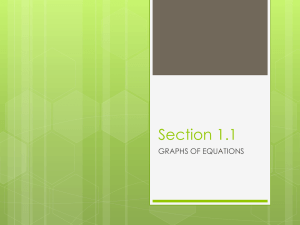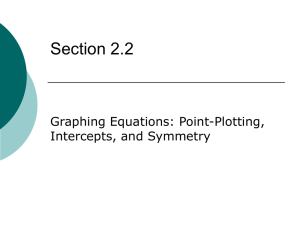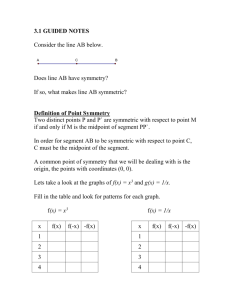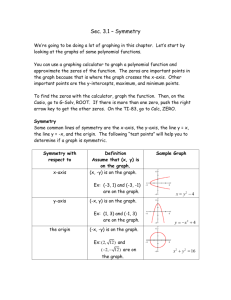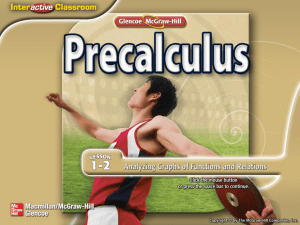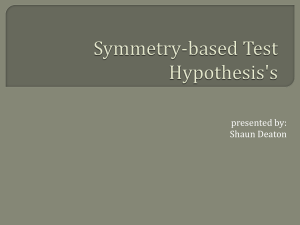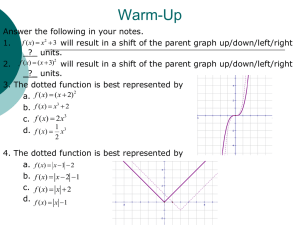3.1 Symmetry & Coordinate Graphs
advertisement
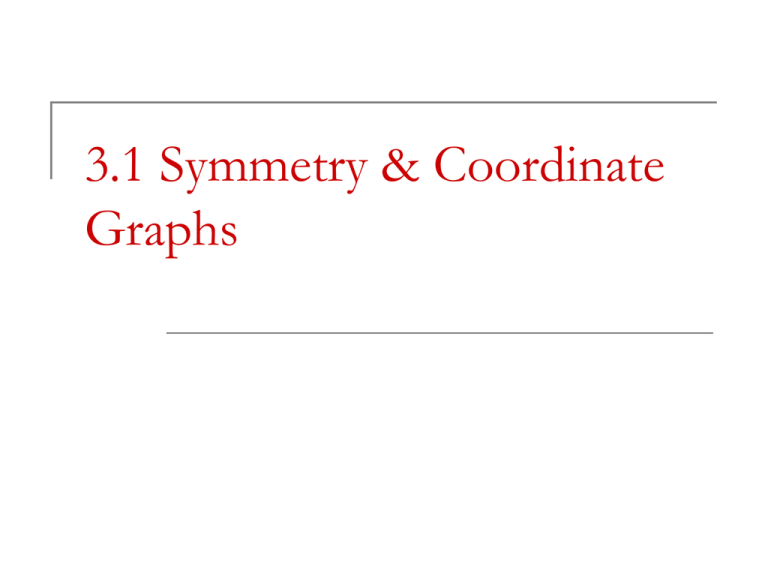
3.1 Symmetry & Coordinate Graphs I. Symmetry Point symmetry – two distinct points P and P’ are symmetric with respect to point M if and only is M is the midpoint of PP ' When the definition is extended to a set of points, such as a graph of a function, then each point P in the set must have an image point P’ that is also in the set. A figure that is symmetric with respect to a given point can be rotated 180 degrees about that point and appear unchanged. A. Symmetry with Respect to the Origin Symmetry with respect to the origin A function has a graph that is symmetric with respect to the origin if and only if f(-x) = -f(x) for all x in the domain of f. A graph will have symmetry about the origin if we get an equivalent equation when all the y’s are replaced with -y and all the x’s are replaced with -x. So for every point (x, y) on the graph, the point (-x, -y) is also on the graph. It is a reflection about both the x- and yaxis. Ex 1 Is each graph symmetric with respect to the origin? How do you know? The graph does not appear to be symmetric with respect to the origin. We can verify this algebraically by the following two-step method: Step 1: find f(-x) and –f(x) Step 2: if f(-x) = -f(x), then the graph has symmetry about the origin. If not, then it is not. If you have an equation instead of a function, you can: Step 1: Replace all x’s with –x and all y’s with –y. Step 2: if you get the same equation, then it is equivalent about the origin. −𝑓 𝑥 = −𝑥 6 ≠ 𝑓 −𝑥 = 𝑥 6 No, f(x) = x6 is not symmetric with respect to the origin. Ex 1 Is each graph symmetric with respect to the origin? How do you know? The graph appears to be symmetric about the origin, but lets check algebraically. Remember the two steps: Step 1: find f(-x) and –f(x) Step 2: if f(-x) = -f(x), then the graph has symmetry about the origin. If not, then it is not. −𝑓 𝑥 = 3𝑥 3 − 5𝑥 = −𝑓 𝑥 = 3𝑥 3 − 5𝑥 Yes, 𝑓 𝑥 = −3𝑥 3 + 5𝑥 is symmetric with respect to the origin. B. Line symmetry Two points P and P’ are symmetric with respect to a line l if and only if l is the perpendicular bisector of PP ' A point P is symmetric to itself with respect to line l if and only if P is on l. Graphs that have line symmetry can be folded along the line of symmetry so that the two halves match exactly. Some graphs, such as the graph of an ellipse, have more than one line of symmetry. Common lines of symmetry: x-axis, y-axis, y = x and y = -x. Ex 2: Determine whether the graph of x2 + y = 3 is symmetric with respect to the x-axis, y-axis, the line y = x, the line y = -x, or none of these. Answer: y-axis You can figure this out without actually graphing the equation. Here is how: Symmetry with respect to the line: Test Results x-axis (a, b) and (a, -b) should produce equivalent equations. x2 + y = 3 x2 + y = 3 a2 + b = 3 a2 - b = 3 No, these are not equivalent equations, so it is not symmetric with respect to the x-axis. y-axis (a, b) and (-a, b) should produce equivalent equations. x2 + y = 3 x2 + y = 3 a2 + b = 3 a2 + b = 3 Yes, these are equivalent equations, so it is symmetric with respect to the y-axis. y=x (a, b) and (b, a) should produce equivalent equations. x2 + y = 3 x2 + y = 3 a2 + b = 3 b2 + a = 3 No, these are not equivalent equations, so it is not symmetric with respect to the line y = x. y = -x (a, b) and (-b, -a) should produce equivalent equations. x2 + y = 3 x2 + y = 3 a2 + b = 3 b2 - a = 3 No, these are not equivalent equations, so it is not symmetric with respect to the line y = -x. Ex 3: Determine whether the graph 𝑦 = 𝑥 + 1 is symmetric with respect to the x-axis, y-axis, both or neither. Test both: Symmetry with respect to the line: Test Results x-axis (a, b) and (a, -b) should produce equivalent equations. 𝑦 = 𝑥 +1 𝑦 = 𝑥 +1 𝑎 = 𝑏 +1 𝑎 = 𝑏 +1 Yes, these are equivalent equations, so it is symmetric with respect to the x-axis. y-axis (a, b) and (-a, b) should produce equivalent equations. 𝑦 = 𝑥 +1 𝑦 = 𝑥 +1 𝑎 = 𝑏 +1 𝑎 = 𝑏 +1 Yes, this are equivalent equations, so it is symmetric with respect to the y-axis. Answer: Both II. Even, Odd, or Neither Functions Not to be confused with End Behavior To determine End Behavior, we check to see if the leading degree is even or odd With Functions, we are determining SYMMETRY (if the entire function is even, odd, or neither) A. Symmetric with respect to the y-axis Symmetric with respect to the origin To determine whether a function is even, odd, or neither, determine whether f(-x) = f(x) (even), f(-x) = -f(x) (odd), or neither. Ex. 1 Even, Odd or Neither? Graphically f ( x) x x 3 Algebraically 𝑓 −𝑥 = (−𝑥)3 −(−𝑥) 𝑓 −𝑥 = −𝑥 3 + 𝑥 Ex. 2Even, Odd or Neither? Graphically f ( x) x 1 2 Algebraically f ( x) x 1 2 f(-x)=(-x)2+1 f(-x)=x2+1 Ex. 3 Even, Odd or Neither? Graphically f ( x) x 1 3 Algebraically f ( x) x 1 3 f(-x) = (-x)3-1 f(-x) = -x3-1 Ex. 4 Even, Odd or Neither? f ( x) 2 x 3 4 f ( x) x x 3 B. Copy and complete the graph so that it is an even function and then an odd function. Even: symmetric about the y-axis Odd: Symmetric about the origin
